Ocean currents in the deep sea are creating microplastic hotspots which house around 1.9 million tiny pieces of debris per square metre, scientists have said.
Researchers believe these slow-moving currents, which also supply oxygen and nutrients to deep-sea creatures, are directing the flow of plastics towards these areas, resulting in so-called “garbage patches” deep in the ocean.
They fear concentrations of toxic microplastics in these areas are increasing the risk of ingestion by the wildlife.
The scientists hope their findings, published in the journal Science, will help direct research into the impact of microplastics on marine life.
Read more about marine pollution:
- Ocean plastics smell like food to turtles
- Microplastic pollution threatens hermit crab populations
- Drowning in plastic: can we solve the marine pollution problem?
Dr Florian Pohl, of the Department of Earth Sciences at Durham University, one of the study authors, said: “It’s unfortunate, but plastic has become a new type of sediment particle, which is distributed across the seafloor together with sand, mud and nutrients.
“Thus, sediment-transport processes such as seafloor currents will concentrate plastic particles in certain locations on the seafloor, as demonstrated by our research.”
More than 10 million tons of plastic waste enters the oceans each year, but plastic that floats on the surface of the sea accounts for only one per cent.
The rest is thought to be present in the deep ocean, but until now it has been unclear where the debris ended up.

Microplastics are small pieces of fibres and plastic which are less than 5mm long.
They come from the fibres of textiles and clothing that are small enough to pass through the filter systems in domestic waste water treatment plants as well as fishing nets and other sources, such as shipping and oil and gas industries.
In the ocean, these fine-grained particles are transported by powerful currents to the bottom of the ocean, resulting in large sediment accumulations called contourite drifts.
The team collected sediment samples from the seafloor of the Tyrrhenian Sea, which is part of the Mediterranean Sea, and analysed them to determine the type of plastic present in the deep sea.
The researchers then developed models of deep ocean currents, showing how these movements controlled the distribution of microplastics on the seafloor.
How do we solve the plastic problem?
- Plastic waste: how can I reduce the amount that ends up in landfill?
- Washing laundry on a delicate cycle releases more plastic microfibres into the ocean
- 13 things you can do to help the planet
Dr Ian Kane, of the University of Manchester, who led the study, said: “Almost everybody has heard of the infamous ocean ‘garbage patches’ of floating plastic, but we were shocked at the high concentrations of microplastics we found in the deep seafloor.
“We discovered that microplastics are not uniformly distributed across the study area; instead they are distributed by powerful seafloor currents which concentrate them in certain areas.”
The team believes the study will help predict the locations of other deep sea hotspots.
Dr Mike Clare, of the National Oceanography Centre in Southampton, who was a co-lead on the research, said: “Our study has shown how detailed studies of seafloor currents can help us to connect microplastic transport pathways in the deep-sea and find the ‘missing’ microplastics.
“The results highlight the need for policy interventions to limit the future flow of plastics into natural environments and minimise impacts on ocean ecosystems.”
Reader Q&A: How do microbeads affect fish?
Asked by: Susie Adams, Portsmouth
There’s no doubt that fish and other aquatic animals eat plastic fragments (under 5mm). These include ‘microbeads’ that are added to toiletries and household products, as well as fibres washed from synthetic clothing. A recent study found three-quarters of flatfish in the River Thames have eaten microplastics. Even deep-sea animals have synthetic fibres in their guts.
The impacts of this are complex. Some animals suffer from blocked digestive tracts, leading to starvation. Another concern is poisoning from microplastics coated in toxic chemicals. There’s still much we don’t know about exactly how plastics and toxins accumulate in food webs.
Read more:
